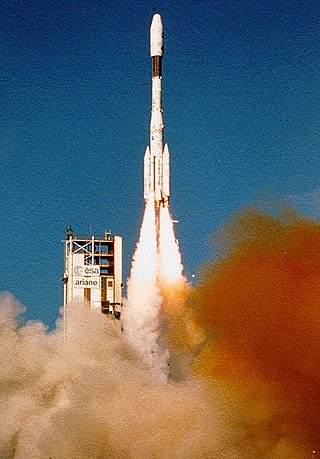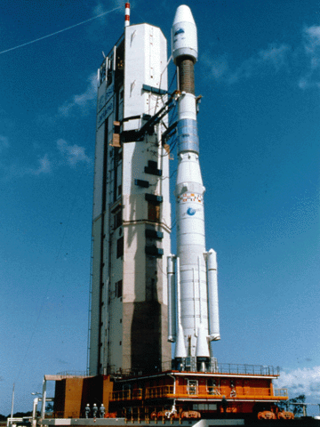Related Research Articles

Ariane 5 is a retired European heavy-lift space launch vehicle developed and operated by Arianespace for the European Space Agency (ESA). It was launched from the Centre Spatial Guyanais (CSG) in French Guiana. It was used to deliver payloads into geostationary transfer orbit (GTO), low Earth orbit (LEO) or further into space. The launch vehicle had a streak of 82 consecutive successful launches between 9 April 2003 and 12 December 2017. Since 2014, Ariane 6, a direct successor system, is in development.

Ariane is a series of European civilian expendable launch vehicles for space launch use. The name comes from the French spelling of the mythological character Ariadne. France first proposed the Ariane project and it was officially agreed upon at the end of 1973 after discussions between France, Germany and the UK. The project was Western Europe's second attempt at developing its own launcher following the unsuccessful Europa project. The Ariane project was code-named L3S.

The Ariane 4 was a European expendable launch vehicle, developed by the Centre national d'études spatiales (CNES), the French space agency, for the European Space Agency (ESA). It was manufactured by ArianeGroup and marketed by Arianespace. Since its first flight on 15 June 1988 until the final flight on 15 February 2003, it attained 113 successful launches out of 116 total launches.

Ariane 1 was the first rocket in the Ariane family of expendable launch systems. It was developed and operated by the European Space Agency (ESA), which had been formed in 1973, the same year that development of the launcher had commenced.

Atlas II was a member of the Atlas family of launch vehicles, which evolved from the successful Atlas missile program of the 1950s. The Atlas II was a direct evolution of the Atlas I, featuring longer first stage tanks, higher-performing engines, and the option for strap-on solid rocket boosters. It was designed to launch payloads into low Earth orbit, geosynchronous transfer orbit or geosynchronous orbit. Sixty-three launches of the Atlas II, IIA and IIAS models were carried out between 1991 and 2004; all sixty-three launches were successes, making the Atlas II a highly reliable space launch system. The Atlas line was continued by the Atlas III, used between 2000 and 2005, and the Atlas V which is still in use.
The highest specific impulse chemical rockets use liquid propellants. They can consist of a single chemical or a mix of two chemicals, called bipropellants. Bipropellants can further be divided into two categories; hypergolic propellants, which ignite when the fuel and oxidizer make contact, and non-hypergolic propellants which require an ignition source.

Avio S.p.A. is an Italian company operating in the aerospace sector with its head office in Colleferro near Rome, Italy. Founded in 1908, it is present in Italy and abroad with different commercial offices and 10 production sites. Avio operates in:
The A2100 is a model of communications satellite spacecraft made by Lockheed Martin Space Systems. It is used as the foundation for telecommunications payloads in geosynchronous orbit, as well as GOES-R weather satellites and GPS Block IIIA satellites. Over 40 satellites use the A2100 bus.
The Intelsat VI series of satellites were the 8th generation of geostationary communications satellites for the Intelsat Corporation. Designed and built by Hughes Aircraft Company (HAC) in 1983-1991, there were five VI-series satellites built: 601, 602, 603, 604, and 605.

Ariane 6 is a European expendable launch system developed by ArianeGroup on behalf of the European Space Agency (ESA). It replaces the Ariane 5, as part of the Ariane launch vehicle family. The stated motivation for Ariane 6 was to halve the cost compared to Ariane 5, and increase the capacity for the number of launches per year.

A liquid apogee engine (LAE), or apogee engine, refers to a type of chemical rocket engine typically used as the main engine in a spacecraft.

SES-10, is a geostationary communications satellite awarded in February 2014, owned and operated by SES and designed and manufactured by Airbus Defence and Space on the Eurostar-3000 satellite bus. It is positioned at the 67° West position thanks to an agreement with the Andean Community to use the Simón Bolivar-2 satellite network. It replaces AMC-3 and AMC-4 to provide enhanced coverage and significant capacity expansion.

ArianeGroup is an aerospace company based in France. A joint venture between Airbus and Safran, the company was founded in 2015 and is headquartered in Issy-les-Moulineaux near Paris. It consists of three core groups: aerospace, defence and security. ArianeGroup has developed its next-generation two-stage Ariane 6 launch vehicle, which succeeded the Ariane 5 rocket, that had more than 110 launches. The new vehicle offers two variants that will be capable of carrying between 10,350 and 21,650 kilograms. The first launch of Ariane 6 is expected to occur in 2024.
JCSAT-1 was a geostationary communications satellite designed and manufactured by Hughes on the HS-393 satellite bus. It was originally ordered by Japan Communications Satellite Company (JCSAT), which later merged into the JSAT Corporation. It had a Ku-band payload and operated on the 150° East longitude until it was replaced by JCSAT-1B.
The BT-4 is a pressure-fed liquid rocket engine designed and manufactured by IHI Aerospace of Japan. It was originally developed for the LUNAR-A project, but it has been used as a liquid apogee engine in some geostationary communications satellite based on the Lockheed Martin A2100 and GEOStar-2 satellite buses. It has also been used on the HTV and Cygnus automated cargo spacecraft.
Eutelsat 8 West B is a geostationary communications satellite. Operated by Eutelsat, it provides direct-to-home (DTH) broadcasting services from geostationary orbit. The satellite is part of Eutelsat's constellation at a longitude of 8° West. Eutelsat announced the order of a new Spacebus-4000C3 satellite bus from Thales Alenia Space in October 2012.
The Orbital Propulsion Centre Lampoldshausen, a Division of ArianeGroup, is the European competence centre for development and production of satellite and orbital propulsion systems. Founded in 1963 by Ludwig Bölkow as a branch of the Bölkow-Entwicklungs-KG, the centre is situated within the German Aerospace Center (DLR) site at Lampoldshausen, Germany.
Curie is a liquid-propellant rocket engine designed and manufactured by Rocket Lab. A bipropellant is used for the propulsion of the third stage/kick stage of the Electron rocket, as well as the Photon. The composition of the propellant is a trade secret.
Eutelsat 172B is a French communications satellite built by Airbus Defence and Space and operated by Eutelsat Communications. Launched on June 1, 2017, it has an expected service life of 15 years. Its orbit along with Eutelsat 172A allows it to cover the Asia-Pacific region, providing enhanced broadband and broadcast services.
The Hispasat 1D, since 2016 called Hispasat 30W-4 is a Spanish communications satellite launched in 2002 operated by Hispasat. Together with the Hispasat 1C it formed a constellation in order to strengthen communication ties between the American continent and the Iberian Peninsula for both governmental and private uses.
References
- 1 2 3 "400 N Bipropellant Apogee Motors". ArianeGroup. Retrieved 2017-08-03.
- ↑ "Model No S400 - 15 Elevation Dimensions" (gif). Airbus Defense & Space. 2013. pp. 8–9. Retrieved 2015-06-15.
- ↑ "Orbital Propulsion Centre, Lampoldshausen, Germany".
- ↑ "CHEMICAL BI-PROPELLANT THRUSTER FAMILY" (PDF). Airbus Defense & Space. 2013. pp. 8–9. Retrieved 2015-06-15.
